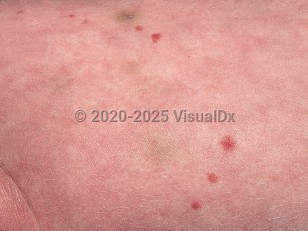Hermansky-Pudlak syndrome in Adult
Alerts and Notices
Important News & Links
Synopsis

Hermansky-Pudlak syndrome consists of a group of genetically heterogeneous disorders resulting from homozygous mutations in at least 9 genes. The major features include oculocutaneous albinism, immunodeficiency, abnormal bleeding, and lysosomal ceroid storage. Bleeding abnormalities include prolonged bleeding time and defective platelet aggregation. Platelets lack the usual dense bodies. Hypopigmentation is notable in the skin, eyes, and hair, but excess pigmentation is seen in reticuloendothelial cells.
The disorder may be the most common single gene disorder in Puerto Rico, where the carrier frequency has been estimated to be as high as 1 in 21 individuals.
The disorder may be the most common single gene disorder in Puerto Rico, where the carrier frequency has been estimated to be as high as 1 in 21 individuals.
Codes
ICD10CM:
E70.331 – Hermansky-Pudlak syndrome
SNOMEDCT:
9311003 – Hermansky-Pudlak syndrome
E70.331 – Hermansky-Pudlak syndrome
SNOMEDCT:
9311003 – Hermansky-Pudlak syndrome
Look For
Subscription Required
Diagnostic Pearls
Subscription Required
Differential Diagnosis & Pitfalls

To perform a comparison, select diagnoses from the classic differential
Subscription Required
Best Tests
Subscription Required
Management Pearls
Subscription Required
Therapy
Subscription Required
References
Subscription Required
Last Updated:01/17/2022
Hermansky-Pudlak syndrome in Adult

